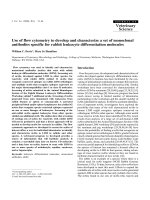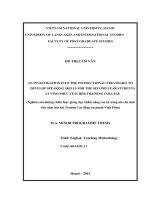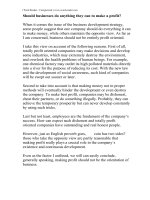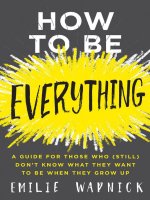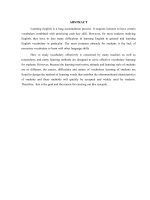what learning strategies should learners use if they want to develop reading skills edited
Bạn đang xem bản rút gọn của tài liệu. Xem và tải ngay bản đầy đủ của tài liệu tại đây (68.87 KB, 7 trang )
i
Topic 4:
Question 1.
Look at the description of the following learner. Imagine you are his/her
teacher, analyze how the following characteristics might influence the way they learn
English and the way you should teach them. You should write no longer than 500
words.
Nation
Vietnam
Age
14
Learning style
Auditory, kinaesthetic, group
Motivation for
learning English
Likes English and Science
Question 2.
What learning strategies should learners use if they want to develop reading
skills? You should write no longer than 500 words.
ii
Question 1.
The Constitution of Vietnam stipulates that Vietnamese is the national language
of Vietnam. Nevertheless, English is an officially taught foreign language subject in
the national education system and is also studied or used by many classes of people in
the trade, increasing the demand for learning English (Nguyen, 2016). Typically, the
English centres continuously open new branches. However, it is necessary to group
learners with criteria such as age, learning style and their English-learning motivation
to develop effective teaching solutions for each group.
Firstly, suppose the 5-12 years old period is the time to develop thinking and
form the first background knowledge. In that case, the 14-year-old stage of
"Teenagers" is the time to receive, build and supplement strong knowledge for future
cognitive development (Kemper and Verschuur, 1981). However, the age of 14 is also
a period of many changes in physiological and emotional aspects. Children often have
mood swings and are easily irritable, stressed, and anxious, but sometimes very
confident. At this age, students tend to be curious to learn more about nature, culture
and society (Miller, 2007). Therefore, English lessons are integrated with this
knowledge, stimulating learning ability and excitement for young learners. From there,
they will be more active in seeking new information and knowledge.
Secondly, each student has their strengths in the learning process. Although
listening skills in English are tricky for learners, the popularity of songs and movies
from the US-UK has greatly inspired auditory learning in Vietnam. Since they receive
information better by listening, several measures improve learning efficiency, such as
letting children read aloud to themselves and listen to audiobooks and music while
studying. Along with that, with the trend of learning combined with practice,
kinesthetic learners have more and more opportunities to develop their abilities.
Teachers and parents should make time for children to alternate with learning for
children in this group. Some simple ways can include organizing extra-curricular
sessions, having children study at a standing desk or even learning on foot. Children
often lose focus and conflict when studying in groups because each group member will
have different views and personalities. However, team-based learners will be
1
motivated to learn, develop multi-dimensional views, reduce pressure and practice
effective teamwork.
Thirdly, the students who like English and Science will be more interested in
lectures related to nature, society, maths and applications. Therefore, the most
effective way to keep students interested is to combine Science and English by
introducing more English vocabulary to science and introducing students to video
channels about science. Such as HowStuffWorks, NASA Discovery, LiveScience and
ScienceDaily.
In summary, to develop effective teaching solutions for each group, it is
necessary to group learners based on age, learning style, and English-learning
motivation criteria. For 14-year-old students who are auditory, kinaesthetic and teambased learners, it is advisable to organize extra-curricular sessions and watch science
videos in English to supplement their learning at school.
Question 2.
Listening, speaking, reading and writing are four skills anyone learning English
needs to develop. Additionally, reading is described as a means of communication, and
the primary goal of reading is to make sense of printed or written materials. According
to Robert Lado (1972), the role of reading in foreign language learning is as follows:
learners can practice the language they have learned through listening and speaking
and vocabulary gained from reading can be reused in writing. English learning
strategies can help students distinguish between critical and irrelevant information.
These strategies are usually related to the acquisition, interaction or focus on form,
which will be explained in the following paragraph:
The language acquisition theory of professor Stephen Krashen asserts that it is
necessary to understand how the human brain absorbs languages to teach foreign
languages effectively. Interaction in second language learning focuses on the character
of the interaction between a language learner and those with whom he or she interacts
and how such communication aids in second language acquisition (Kemper and
Verschuur, 1981). Furthermore, focus on form (FonF) is a language education
2
approach in which participants are made aware of the grammatical form of language
functionalities they are already capable of using (Bühler, Goodwin and Eschbach,
2011). From these theory bases, this essay discusses some strategies for English
learners to improve reading skills effectively; specifically, learners should apply
strategies related to language acquisition theory, such as:
Increase vocabulary: According to the acquisition principle, the more words
students know, the faster they will read (Čičak and Sicherl, 2018). Therefore, before
improving their reading speed in English, readers need to hone their vocabulary. They
should buy or download a new word learning app Flashcard and form a habit of
learning new words every day. Following the FonF approach, besides learning
vocabulary, learners should learn the meaning of prepositions and adjective phrases
that go with common prepositions or basic grammar rules so they do not waste time
looking up this content.
High Concentration: Fast reading with deep comprehension requires intense
concentration. Readers must find a reading location where little noise or distractions
disrupt reading. While reading, pay close attention to the text, avoid losing focus, and
read without paying attention to the content.
Understand the gist: Watching the trailer before watching the movie will
provide a brief overview of the content and the ability to judge whether this movie is
appropriate. Likewise, skimming before serious reading helps learners sketch out the
basics of the text. Before reading any text, readers should read quickly from beginning
to end, paying attention to the main heading, subheading, or information highlighted
from the usual, such as bold, stylized font. If the text has a table of contents or the
book has an introduction on the back of the cover, readers should read it before going
through the full text and considering any available images or graphs.
English learning strategies are typically associated with acquisition, interaction,
or a focus on form. However, because of the characteristics of reading skills, the
interaction theory in learning has not been applied to provide strategies. However,
using the theory of language acquisition and a focus on form, this study proposed
strategies to improve reading skills, such as increasing vocabulary, maintaining high
concentration and understanding the gist.
3
4
REFERENCES
Bühler, K., Goodwin, D. and Eschbach, A., 2011. Theory of language.
Amsterdam: John Benjamins Pub. Co.
Kemper, H. and Verschuur, R., 1981. Errata of: Maximal Aerobic Power in 13and 14-Year-Old Teenagers in Relation to Biological Age. International Journal of
Sports Medicine, 02(04), pp.21-22.
Kemper, H. and Verschuur, R., 1981. Maximal Aerobic Power in 13- and 14Year-Old Teenagers in Relation to Biologic Age*. International Journal of Sports
Medicine, 02(02), p.12.
Lado, R., 1972. Evidence for an Expanded Role for Reading in Foreign
Language Learning. Foreign Language Annals, 5(4), pp.451-454.
Miller, C., 2007. Tales from a 14-Year Old (and Growing…) Application. Part
1: Setting the Stage. NIR news, 18(4), pp.20-22.
Nguyen, N., 2016. Thirty Years of English Language and English Education in
Vietnam. English Today, 33(1), pp.33-35.
5
